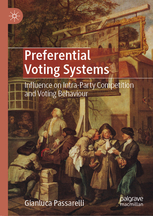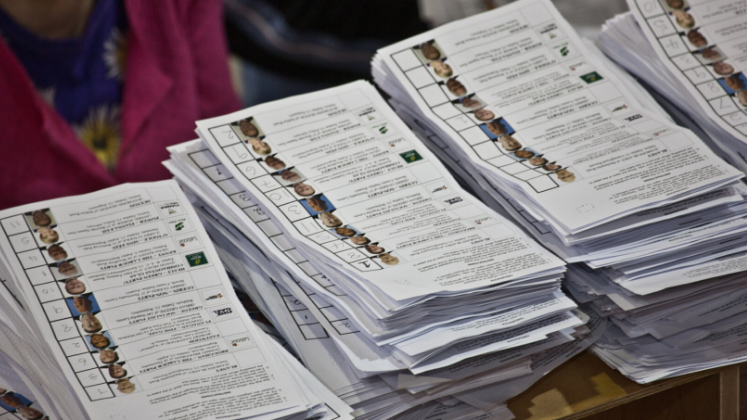In Preferential Voting Systems: Influence on Intra-Party Competition and Voting Behaviour, Gianluca Passarelli offers a new study of the impact of preferential voting on intra-party competition, facilitated by an extensive number of case studies drawn from nineteen countries. This is an important contribution to the literature on electoral systems, filling a particular gap on preferential voting, writes Gary Wilson, and will also appeal to those with an interest in electoral reform.
Preferential Voting Systems: Influence on Intra-Party Competition and Voting Behaviour. Gianluca Passarelli. Palgrave Macmillan. 2020.
 Although there is a considerable body of literature on electoral systems in general, there is relatively little in respect of specific electoral systems. Furthermore, much of the literature is concerned principally with the merits of various electoral systems vis-à-vis one another, as opposed to considering their more particular effects. Preferential voting systems are one means of effecting proportional representation, yet their consideration has been largely confined to more general discussions. This new comprehensive work by Gianluca Passarelli is, therefore, a very welcome addition to the existing material on electoral systems, focusing specifically as it does on the underexplored area of preferential voting systems.
Although there is a considerable body of literature on electoral systems in general, there is relatively little in respect of specific electoral systems. Furthermore, much of the literature is concerned principally with the merits of various electoral systems vis-à-vis one another, as opposed to considering their more particular effects. Preferential voting systems are one means of effecting proportional representation, yet their consideration has been largely confined to more general discussions. This new comprehensive work by Gianluca Passarelli is, therefore, a very welcome addition to the existing material on electoral systems, focusing specifically as it does on the underexplored area of preferential voting systems.
A principal proclaimed strength of preferential voting systems over other forms of proportional representation is that they are potentially capable of maximising the power of voters by allowing them to indicate a preference for an individual candidate or candidates from the same party, choice not being unduly restricted to a single candidate or ordered list imposed by the party.
Passarelli’s key objective in this book is to consider specifically the impact of preferential voting systems on intra-party competition, facilitated by his use of an extensive number of case studies drawn from numerous countries. In a system whereby voters may choose some, while simultaneously rejecting other, candidates from the same party, there is real scope for intra-party competition to spill out into a general election, which in a more restrictive electoral system would only ever occur during internal party candidate selection processes.

In the first two chapters Passarelli provides the necessary context and framework for his study. Chapter One is concerned with the book’s theoretical approach. Passarelli provides definitional clarification at this stage in respect of the book’s subject matter, identifying two main categories of preferential voting and four types of what he labels ‘Preferential List Proportional Representation’ (PLPR) electoral systems. Tables are usefully utilised to indicate the case studies which will be employed in the book, as well as to break down the countries considered by reference to the types of elections for which they use preferential voting.
In the second chapter, issues relating to the book’s starting hypotheses, use of data and methodology are addressed. Passarelli’s analysis focuses on a sample of nineteen countries which have all used preferential voting systems recently and draws on data from the period 1945-2016.The main stated goal is to investigate the effects of preferential voting on voters, parties and candidates. Passarelli hopes to offer an analysis of preferential voting from a comparative perspective, by first detailing the systems under consideration before proceeding to draw on data on preferential voting and its consequences.
At this stage, he sets out six hypotheses which his analysis will test. These include the expectation that there will be greater intra-party competition and parliamentary turnover, simultaneously weakening party cohesiveness and reducing the likelihood of fragmentation of the party system. In short, this is expected to occur as a result of preferential voting leading voters to place greater emphasis on casting votes for individual candidates on the basis of their personal qualities, in turn weakening the influence of political parties over the identity of elected candidates and their ability to appeal en bloc to voters. At the same time, the enhanced power of individuals over parties reduces the likelihood of their leaving their parties over political disagreement. Electoral volatility and voter turnout are expected to increase due to the greater degree of choice placed in the hands of voters.
The key substantive content contained within the book is found within its two central chapters, concerned respectively with detailing the use of preferential voting across the world, and the consequences of preferential voting. Passarelli suggests that of almost 60 democratic countries surveyed, nearly half have some form of proportional representation, most involving preferential voting. In Chapter Three, Passarelli explains in some detail the key features of the electoral systems which use preferential voting. The vast majority of these are found in Europe, although a number are identified in countries as diverse as Brazil, Iraq and Sri Lanka. Latin America appears to follow Europe as the region with the greatest prevalence of preferential voting.
Chapter Four builds upon this by considering in depth the consequences of preferential voting in each of the case studies. Passarelli deploys a number of considerations in evaluating the relevance of preferential voting in each case. These include the number of incumbents who are re-elected, the level of turnover in elected representatives due to the retirement of outgoing representatives and any decline in general support for the parties to which candidates belong.
Having accounted for these factors, it then becomes possible to establish the extent to which preferential voting plays a role in determining electoral outcomes. The findings of the survey vary from one system to another. Although in some cases the effects of preferential voting appear to be modest at best, in other cases they are notable. Preferential voting is seen as being particularly significant in respect of the electoral experiences of countries including Latvia, Slovenia and Croatia, which registered the highest proportions of voters expressing a preference through voting and in which a smaller level of turnover of elected representatives could be attributed to the retirement of incumbents or general decline in party support.
The main findings drawn from the case studies are explored in the final two chapters. The rather brief fifth chapter draws upon some sophisticated data in order to ascertain the general weight of preferential voting, concluding that overall in Open List and Latent List electoral systems, about 13 per cent of the turnover in elections is down to preferential voting. Chapter Six attempts to draw more substantial conclusions in respect of the factors which in practice determine when preferential voting has the greatest impact on electoral outcomes. Sophisticated statistical formulae are employed here in reaching these conclusions, which are not necessarily easily consumable for the non-statistician. However, the hypotheses postulated by Passarelli at the outset are essentially borne out by his data analysis. There is nonetheless some variation in the effects of preferential voting from one country to another, the electoral system employed in any given setting being especially relevant. Reinforcing an argument developed throughout the book, the higher level of openness which a system permits in terms of providing voters with a meaningful opportunity to express a preference in voting, the greater the prospect that exists for incumbent elected representatives to be defeated at a given election.
This book represents an important contribution to the literature on electoral systems, filling a particular gap in respect of coverage of preferential voting systems. Although its main focus is the effects of preferential voting, it is able to offer much more than this by virtue of the insights which it provides into the dynamics of a significant number of electoral systems. While a generally readable text, its audience could be limited by its considerable use of statistical data and formulae, which may restrict its main appeal to political scientists. It will, however, also appeal to those with interest in electoral reform, for example, who wish to appraise the merits of alternative systems.
Note: This review gives the views of the author, and not the position of the LSE Review of Books blog, or of the London School of Economics.
Image Credit: Irish Election 2011 – The Count At The RDS (William Murphy CC BY SA 2.0).







